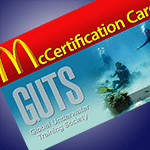Six common mistakes cave divers make when shooting photos and video
![]() Social media can be a great way to share your cave diving experiences with others. It can also be an effective tool for promoting classes, trips and other activities — even if those activities do not involve cavern or cave diving. Unfortunately, most of the cave diving photos and, especially, video we see posted on Facebook, You Tube and Instagram pretty much suck. Which is a shame because they don’t have to.
Social media can be a great way to share your cave diving experiences with others. It can also be an effective tool for promoting classes, trips and other activities — even if those activities do not involve cavern or cave diving. Unfortunately, most of the cave diving photos and, especially, video we see posted on Facebook, You Tube and Instagram pretty much suck. Which is a shame because they don’t have to.






